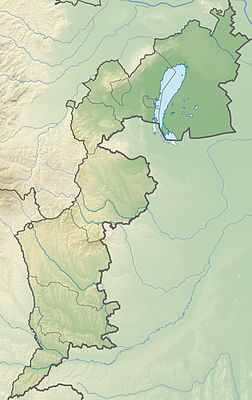Forchtenstein Castle
| Forchtenstein Castle | ||
|---|---|---|
|
West view of Forchtenstein Castle |
||
| Creation time : | from 14th century | |
| Castle type : | Hilltop castle | |
| Conservation status: | Received or received substantial parts | |
| Place: | Forchtenstein | |
| Geographical location | 47 ° 42 '34 " N , 16 ° 19' 51" E | |
|
|
||
The Forchtenstein (ung. Fraknó vára ) is a late medieval castle in the same community Forchtenstein in northern Burgenland in Austria .
location
The castle stands southwest of Mattersburg above the Wulkatal .
history
The first part of the castle with the 50 m high keep was built at the beginning of the 14th century by the lords of Mattersdorf , who later called themselves lords of Forchtenstein .
Around 1450 the Lords of Forchtenstein died out due to a lack of male descendants and the castle came into the possession of the Habsburgs , who owned it for 170 years and pledged it to the Counts of Weißbriach and Hardegg , among others . The festival came to Archduke Albrecht VI. and for a short time it became an important part of a small Habsburg principality. [1]
Not much has changed about the castle during this period. In 1622 Nikolaus Esterházy , tribe lord of the Esterházy family , received the castle from Emperor Ferdinand II in exchange , and the Esterházy family received the title of count. Nicholas began to convert the now dilapidated castle into a fortress . Between 1630 and 1634 he concluded working contracts with the Viennese builder Simone Retacco and from 1643 with the pallier Domenico Carlone for the new construction of the castle. The builders were all Italians. It was a major order for three Kaisersteinbrucher masters , Ambrosius Petruzzy , Pietro Maino Maderno and Mathias Lorentisch . Kaiserstein was used for main portals, fountains, cannon balls, etc. The carved stones were delivered in large stone wagons pulled by six oxen.
His son Paul expanded the castle in the second half of the 17th century according to the plans of the architect Domenico Carlone , whereby emphasis was also placed on artistic design. Due to the many renovations, the castle is actually a baroque castle in its current size. After Paul's death, the purpose of the castle changed. From the previous fortress, it became a storage place for weapons, the princely archive and the princely collection of clocks, automatons, exotic animal preparations and other “miracle things”. The so-called treasure and wonder chamber could only be reached via a secret passage; the door could only be opened with two different keys. One was kept by the prince and the other by the treasurer. These rooms were also not discovered during the occupation after the Second World War and were thus preserved intact. In addition to the actual collection, the cabinets with the original glass panes are also important (see illustration). In the second half of the 18th century the castle was expanded by master builder Johann Ferdinand Mödlhammer . The roof structure was raised and the interior renovated.
During the time of the Hungarian Soviet Republic , 1919, state officials confiscated around 280 objects from the Esterházy treasury for Liechtenstein and brought them to Budapest , where they are still to this day. After the end of the Soviet Republic, the Hungarian state concluded a loan agreement with Esterházy for these objects; Since, in the opinion of the Esterházy Private Foundation, Hungary will no longer fully comply with this in 2019, the Foundation is trying to return its objects.
The castle is owned by the Esterházy Private Foundation and, in addition to the Esterházy Palace in Eisenstadt, shows the history and treasures of the old noble family. After the Esterházy estates were separated into a Hungarian and an Austrian part in 1921, the economic archive material remained in Forchtenstein Castle, while the family archive has since been kept in the Hungarian State Archives in Budapest .
Distant view from the Rosalia
literature
- Adelheid Schmeller-Kitt: Forchtenstein Castle - building history and weapons collection. In: Kurt Rossacher (Ed.), Wilhelm Mrazek (Red.): Old and Modern Art. Austrian magazine for arts, crafts and home decor. No. 91/1967 (XII. Year), ZDB -ID 214656-3 . Österreichischer Bundesverlag for Education, Science and Art, Vienna 1967, OBV , pp. 9–21. - Online at MAK - Austrian Museum of Applied Arts .
- Forchtenstein - Burgenland. In: Gerhard Stenzel: From castle to castle in Austria. 2nd edition, Verlag Kremayr & Scheriau, Vienna 1973, ISBN 3-218-00278-8 , pp. 72-75.
- Jakob Michael Perschy (Red.): Bollwerk Forchtenstein. Forchtenstein Castle, May 15–31. October 1993. Catalog of the Burgenland State Exhibition 1993 . Burgenland research, special volume 11, ZDB -ID 1448585-0 . Office of the Burgenland Provincial Government, Dept. XII / 2 (Ed.), Eisenstadt 1993, OBV .
- Josef Pratl, Heribert Scheck: Esterházy music documents. The music documents in the Esterházy archives and collections in Forchtenstein and Budapest. (= Eisenstädter Haydn reports 10). Hollitzer, Vienna 2017, ISBN 978-3-99012-347-8 .
- Edeltraut Mitterhuber: Life and Work of Pietro Maino Maderno. In: Culture and Education, magazine of the Burgenland Volksbildungswerk , 4th part Burg Forchtenstein in 02/2018 p. 20ff.
Individual evidence
See also
- Forchtenstein Castle in the market town of Neumarkt in the state of Styria in Austria
- List of castles and palaces in Austria
- Rosaliengebirge
Web links
- Literature on Forchtenstein Castle in the catalog of the Austrian Library Association .
- Forchtenstein Castle - Official Homepage
- Aerial views of the castle
- Entry about Forchtenstein on Burgen-Austria








